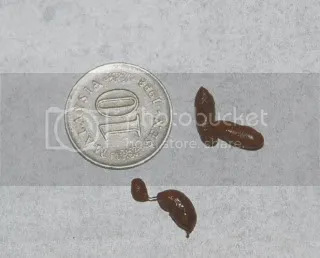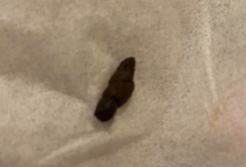This topic of today’s article might seem a little weird: sugar glider poop and pee. However, while it might seem weird at first glance, it’s an important topic to cover. After all, sugar gliders are exotic animals and as such, people have lots of questions about them. One of the topics that people often have questions about and that doesn’t get covered all that frequently is their poop or pee, even though it’s an essential topic. After all, your sugar glider’s waste tells a lot about their health.
For that reason, I’ve created a comprehensive guide that’ll teach you what you need to know about your gliders waste. It might not be the flashiest part of being a pet owner, but it’s important nonetheless, so let’s get started.
What does normal sugar poop look like?
One of the first essential things to cover is what normal sugar glider poop should look like. Knowing what it should look like is essential in knowing if something is wrong with your glider’s poops.
A healthy sugar glider’s poops should have the shape of a pellet, be slightly bigger than that of a mouse, dark brown in color, and quite firm but not all too hard. It also should not smell too strong.
Here are some pictures of normal sugar glider poops:


However, the diet of a sugar glider can affect their poops. If you fed them something like avocado the day before it’s possible that their waste is slightly softer the day after.
This is not necessarily something to be concerned about. However, if they persistently have soft stools it’s a good idea to take them to a vet for a check-up.
On the other hand, if their poops are too hard, they might not be getting enough water or fiber in their diet. They might be dehydrated which can result in harder stools because they do not have enough water to soften the stool. Sugar gliders are prone to dehydration, so make sure that they get enough fluids during the day. However, you should also be careful not to overdo it as too much water intake is also not good.
Striking a good balance is important which can be achieved through a good diet. A good diet for them should mimic closely what they eat in the wild. However, because they’re exotic animals, this can be difficult.
The best diet for them, according to veterinarians, consists mostly of Leadbeater’s mixture, which is a soft mixture made from meat, eggs, honey, and supplements. On top of that, they need pellets, and small amounts of fruits, vegetables, and nuts.
Why is my sugar glider’s poop red/green/orange?
If your sugar glider’s poop is a different color but looks otherwise fine, it might be because you fed them something that changed the color. For instance, watermelon, cherries, or strawberries can make their poop red and leafy greens can make it green.
However, if you notice this and did not change anything in their diet recently, or are just worried, you should always take them to a veterinarian as soon as possible. Sugar gliders are prey animals and are very good at hiding that they’re sick. Make sure that you always get them the care they need. Better safe than sorry!
Sugar glider diarrhea
One issue that sugar gliders quite commonly face is diarrhea. If you notice that your glider has watery poops it’s important to look for other signs of illness because diarrhea might be caused by either sickness (such as Ick) or by something in their diet.
There are many different bacteria and parasites that can cause diarrhea, and, according to the Merck Vet Manual, some of these can actually be harmful to humans. Because of that, it’s important that you use care when handling a sick glider. Make sure to wash your hands frequently and that you thoroughly clean their cage.
Regardless of the cause though, it’s always a good idea to take your glider to a vet as soon as you can if you notice that they have diarrhea because it can be quite serious. In the meantime, make sure that they get enough fluids to avoid dehydration.
How often do sugar gliders poop?
Every sugar glider is different and they don’t all eliminate the same number of times a day. Generally speaking, sugar gliders will release themselves right after they wake up and after eating. However, this not only depends on each individual glider, it also depends on age and on their diet.
Can sugar gliders be trained to use a litter box?
Many sugar glider owners wonder if they can train their gliders to use a litter box because it would help substantially in keeping their cage clean and prevent odor. Unfortunately, sugar gliders are in essence wild animals. Training them to use a litter box will not go very well.
Gliders are quite smart, but efforts to teach them in a designated litter box often fail because it’s simply not in their nature to use one of these.
As a result of them not using a litter box it sometimes happens that they get some of their excrement stuck on their fur. If this happens it’s important that you do not bathe them. Instead, wipe them down with a warm damp towel.
However, while most sugar gliders won’t use a litter box they will often use a designated corner of their cage as a bathroom.
Why does my sugar glider poop and pee on me?
Something that many sugar glider owners struggle with is the fact that their gliders poop or pee on them when they’re trying to hold them. This can be quite annoying, but rest assured that it’s not malicious intent. There are basically 4 reasons why this happens:
- Accidentally. Sugar gliders are in essence wild animals, they cannot let you know that they have to go to the bathroom. So, if you’re holding them and they have to go, they’ll just go. It’s not really their fault.
- Scent marking. Gliders mostly scent-mark with their scent glands but it’s also possible for them to do this with urine.
- Bladder issues. If you notice that your glider has unusual urination habits it might be a good idea to consider bladder issues. If they’re peeing too frequently or it has a strange smell, consider the fact that something might be wrong with their bladder. In that case, a vet visit is highly recommended.
- Stress & Fear. Sugar gliders are tiny animals, especially compared to humans. Because of that, it’s very possible that they’re releasing themselves on you due to stress or fear. This happens most frequently with gliders that are new or are not properly bonded with their owner yet
Another important thing to note is that gliders often release themselves right after they wake up. Because of that, it’s important that you avoid handling them for about 15 to 20 minutes after they wake up. This gives them some time to do their business and avoids accidents.
In addition, it’s a good idea to avoid waking them up from their sleep just to handle them. They’re nocturnal animals and waking them up during the day can cause stress and confusion which can make it more likely for them to urinate or poop on you.
- How Long Do American Eskimo Dogs Live? Important Factors and Care Tips - September 29, 2023
- Do American Bulldogs Need Grooming? Essential Tips and Care Guidelines - September 29, 2023
- Do Bengal Cats Enjoy Playing? Essential Tips for Keeping Them Active - September 29, 2023